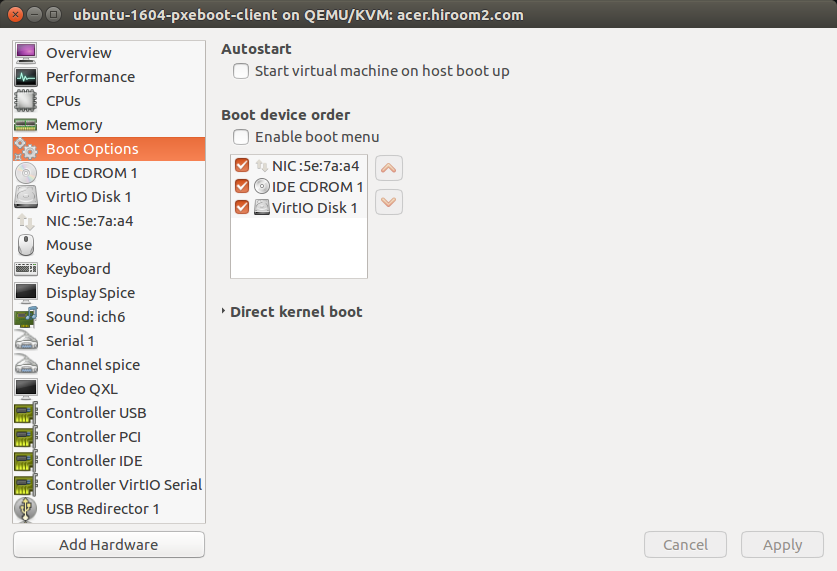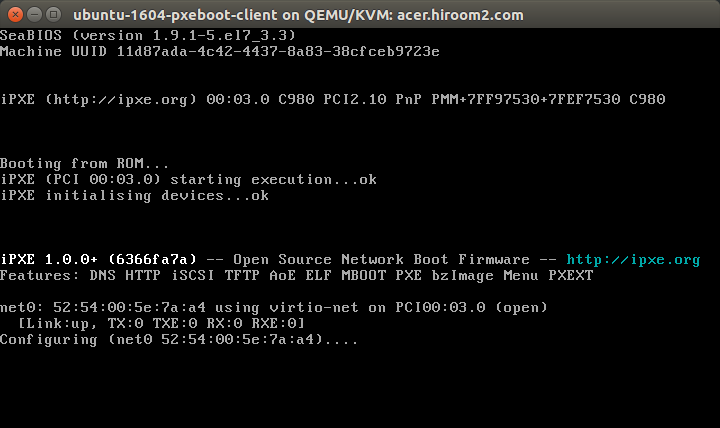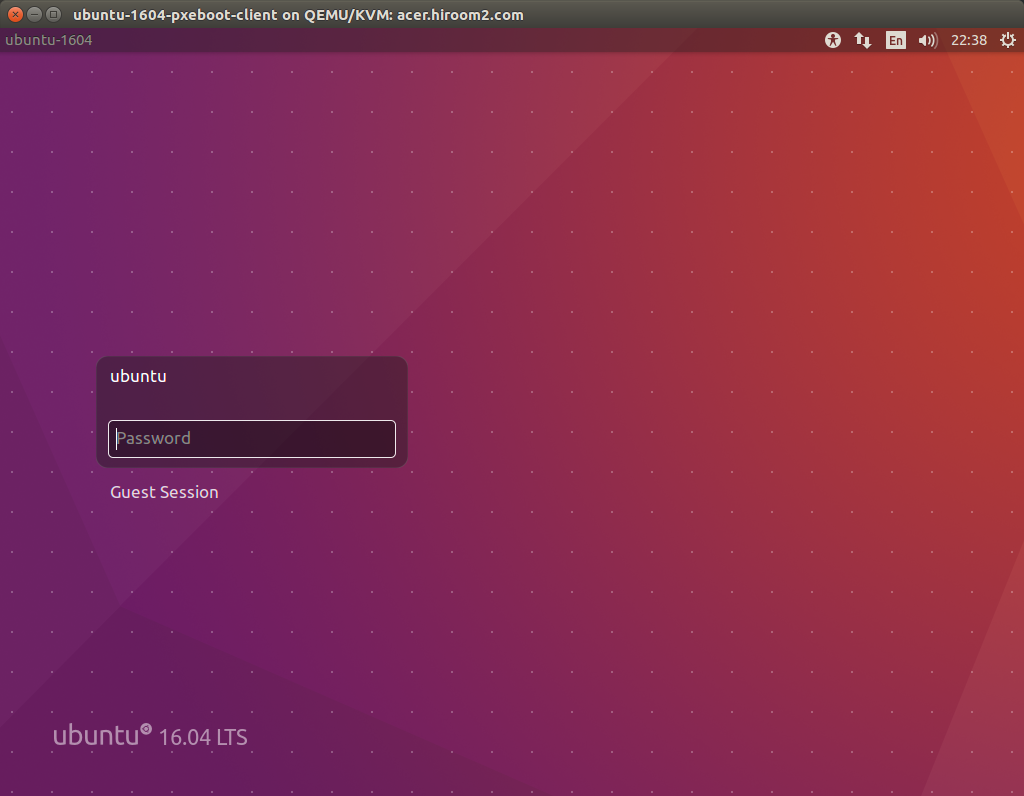This article will run PXE Boot server with NFS for thin client, and run Ubuntu 16.04 on client which is connected to PXE Boot server via network. You do not need to install Ubuntu 16.04 on client.
- 2018/3/31 Fix the problem that /etc/rc.local is not worked on thin client.
Table of Contents
1 Install PXE Boot server
The following script will install PXE Boot server. Change the variables to your environment.
- SERVER_IPADDR is IP adress of PXE Boot server.
- DHCP_SERVER_INTERFACESv4 is network interface name for DHCP. DHCP will be provided via this network interface.
- DHCP_SUBNET is network address for DHCP.
- DHCP_NETMASK is subnet for DHCP.
- DHCP_DNS is DNS for DHCP.
- DHCP_ROUTER is gateway for DHCP.
- DHCP_CLIENT_HOSTNAME is hostname of client.
- DHCP_CLIENT_IPADDR is IP address of client.
- DHCP_CLIENT_MACADDR is MAC address of client.
NFS root filesystem is set to the following.
- root user password is not set. root user is locked.
- Create user which name is "ubuntu" and password is "ubuntu".
- Install unity package, ubuntu-desktop package and openssh-server package.
#!/bin/sh set -e # Change the following variable to yours. [ -z "${SERVER_IPADDR}" ] && \ SERVER_IPADDR=$(hostname -I | awk '{ print $1 }') [ -z "${DHCP_SERVER_INTERFACESv4}" ] && DHCP_SERVER_INTERFACESv4=ens3 [ -z "${DHCP_SUBNET}" ] && DHCP_SUBNET=192.168.11.0 [ -z "${DHCP_NETMASK}" ] && DHCP_NETMASK=255.255.255.0 [ -z "${DHCP_DOMAIN}" ] && DHCP_DOMAIN=hiroom2.com [ -z "${DHCP_DNS}" ] && DHCP_DNS="192.168.11.2, 192.168.11.1" [ -z "${DHCP_ROUTER}" ] && DHCP_ROUTER=192.168.11.1 [ -z "${DHCP_CLIENT_HOSTNAME}" ] && \ DHCP_CLIENT_HOSTNAME=ubuntu-1604-pxeboot-client [ -z "${DHCP_CLIENT_IPADDR}" ] && DHCP_CLIENT_IPADDR=192.168.11.254 [ -z "${DHCP_CLIENT_MACADDR}" ] && DHCP_CLIENT_MACADDR=52:54:00:5e:7a:a4 tftpd_hpa_install() { sudo apt install -y tftpd-hpa sudo systemctl enable tftpd-hpa sudo systemctl restart tftpd-hpa } isc_dhcp_server_install() { sudo apt install -y isc-dhcp-server sudo sed -e 's/^#DHCPDv4_CONF=/DHCPDv4_CONF=/g' \ -e 's/^#DHCPDv4_PID=/DHCPDv4_PID=/g' \ -e "s/INTERFACESv4=\"\"/INTERFACESv4=\"${DHCP_SERVER_INTERFACESv4}\"/g" \ -i /etc/default/isc-dhcp-server cat <<EOF | sudo tee /etc/dhcp/dhcpd.conf subnet ${DHCP_SUBNET} netmask ${DHCP_NETMASK} { option domain-name "${DHCP_DOMAIN}"; option domain-name-servers ${DHCP_DNS}; option routers ${DHCP_ROUTER}; next-server ${SERVER_IPADDR}; filename "pxelinux.0"; } host ${DHCP_CLIENT_HOSTNAME} { hardware ethernet ${DHCP_CLIENT_MACADDR}; fixed-address ${DHCP_CLIENT_IPADDR}; } EOF sudo systemctl restart isc-dhcp-server } nfs_kernel_server_install() { # Set NFS server. sudo apt install -y nfs-kernel-server debootstrap systemd-container sudo mkdir /var/lib/nfsroot echo "/var/lib/nfsroot *(rw,sync,no_root_squash,no_subtree_check)" | \ sudo tee /etc/exports sudo exportfs -ra # Create root filesystem. URL=$(grep "^deb .* xenial main" /etc/apt/sources.list | awk '{ print $2 }') sudo debootstrap xenial /var/lib/nfsroot "${URL}" # Get debconf from server for locale and keyboard. sudo apt install -y debconf-utils systemd-container sudo debconf-get-selections | grep locale | \ sudo tee /var/lib/nfsroot/debconf.txt sudo debconf-get-selections | grep keyboard-configuration | \ sudo tee -a /var/lib/nfsroot/debconf.txt sudo cp /etc/locale* /var/lib/nfsroot/etc/ sudo cp /etc/default/locale /var/lib/nfsroot/etc/default/ # resolv.conf is not updated by systemd-nspawn. sudo cp /etc/resolv.conf /var/lib/nfsroot/etc/resolv.conf.server sudo systemd-nspawn -D /var/lib/nfsroot sh -c " set -e # Use server resolv.conf. rm -f /etc/resolv.conf mv /etc/resolv.conf.server /etc/resolv.conf apt update -y apt upgrade -y # Set debconf to client for locale and keyboard. cat debconf.txt | debconf-set-selections apt install --reinstall -y locales keyboard-configuration rm -f debconf.txt # Install kernel and create initrd. apt install -y initramfs-tools linux-image-generic cat <<EOF > /etc/initramfs-tools/initramfs.conf MODULES=netboot BUSYBOX=auto KEYMAP=n COMPRESS=gzip DEVICE= NFSROOT=${SERVER_IPADDR}:/var/lib/nfsroot BOOT=nfs EOF update-initramfs -tu # Install Unity and OpenSSH server. apt install -y ubuntu-desktop unity openssh-server # Set root password and create user. useradd -m -s /bin/bash ubuntu yes ubuntu | passwd ubuntu gpasswd -a ubuntu sudo # systemd needs /etc/fstab entry too while using nfsroot. echo '${SERVER_IPADDR}:/var/lib/nfsroot / nfs defaults 0 0' > /etc/fstab sudo sed -e 's/^dns=dnsmasq/#dns=dnsmasq/g' \ -i /etc/NetworkManager/NetworkManager.conf # Generate /etc/resolv.conf with dhclient. rm -f /etc/resolv.conf ln -s /run/resolvconf/resolv.conf /etc/resolv.conf cat <<EOF > /etc/rc.local #!/bin/sh -e dhclient EOF " } pxelinux_install() { cd /var/lib/tftpboot sudo apt install -y pxelinux syslinux sudo cp -a /usr/lib/syslinux/modules/bios . sudo cp /usr/lib/PXELINUX/pxelinux.0 . sudo cp /usr/lib/syslinux/modules/bios/ldlinux.c32 . sudo cp /var/lib/nfsroot/vmlinuz . sudo chmod 744 vmlinuz sudo cp /var/lib/nfsroot/initrd.img . sudo chmod 744 initrd.img sudo mkdir pxelinux.cfg cat <<EOF | sudo tee pxelinux.cfg/default path bios include menu.cfg default bios/vesamenu.c32 prompt 0 timeout 10 EOF cat <<EOF | sudo tee menu.cfg menu hshift 13 menu width 49 menu margin 8 menu tabmsg menu title Thin client boot menu label ubuntu-1604-thin-client menu label ^Ubuntu 16.04 thin client kernel vmlinuz append vga=788 initrd=initrd.img ip=dhcp nfsroot=${SERVER_IPADDR}:/var/lib/nfsroot rw menu end EOF } pxeboot_main() { tftpd_hpa_install isc_dhcp_server_install nfs_kernel_server_install pxelinux_install } pxeboot_main
2 Run Ubuntu 16.04 thin client with NFS
This article runs Ubuntu 16.04 thin client on virtual machine on KVM. Virtual machine on VirtualBox and real machine too can run Ubuntu 16.04
thin client with enabling network boot. Please check your BIOS setting.
Enable "NIC" of "Boot device order" and make it top of order with virt-manager.

iPXE sends DHCP requests, receives DHCP response from PXE Boot server, download and run boot image.

syslinux's menu is displayed. After 1 second, "Ubuntu 16.04 thin client" will be selected automatically.

Ubuntu 16.04 thin client is started.

Login is displayed.
